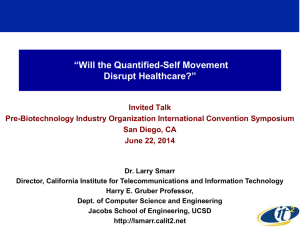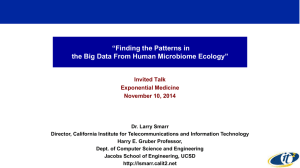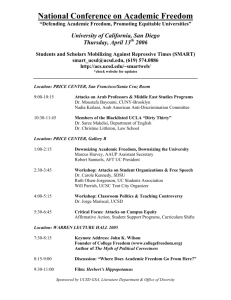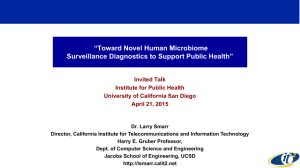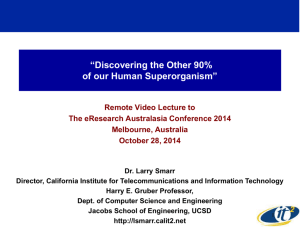PPT - Larry Smarr - California Institute for Telecommunications and
advertisement
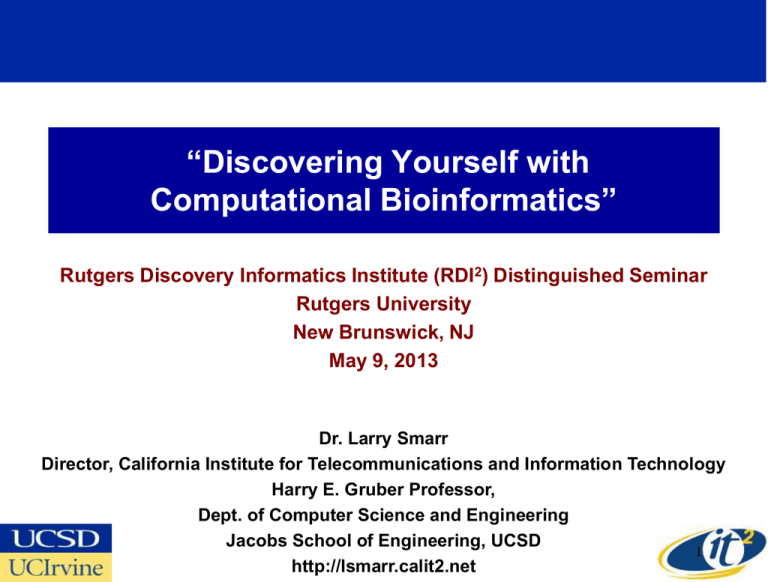
“Discovering Yourself with Computational Bioinformatics” Rutgers Discovery Informatics Institute (RDI2) Distinguished Seminar Rutgers University New Brunswick, NJ May 9, 2013 Dr. Larry Smarr Director, California Institute for Telecommunications and Information Technology Harry E. Gruber Professor, Dept. of Computer Science and Engineering Jacobs School of Engineering, UCSD 1 http://lsmarr.calit2.net Abstract For over a decade, Calit2 has had a driving vision that healthcare is being transformed into “digitally enabled genomic medicine.” Combined with advances in nanotechnology and MEMS, a new generation of body sensors is rapidly developing. As these real-time data streams are stored in the cloud, cross population comparisons becomes increasingly possible and the availability of biofeedback leads to behavior change toward wellness. To put a more personal face on the "patient of the future," I have been increasingly quantifying my own body over the last ten years. In addition to external markers I also currently track over 100 blood biomarkers and dozens of molecular and microbial variables in my stool. Using my saliva 23andme.com obtained 1 million single nucleotide polymorphisms (SNPs) in my human DNA. My gut microbiome has been metagenomically sequenced by the J. Craig Venter Institute, yielding 25 billion DNA bases. I will show how one can discover emerging disease states before they develop serious symptoms using this Big Data approach. Hundreds of thousands of supercomputer CPU-hours were used in this voyage of self-discovery. Where I Believe We are Headed: Predictive, Personalized, Preventive, & Participatory Medicine I am Lee Hood’s Lab Rat! www.newsweek.com/2009/06/26/a-doctor-s-vision-of-the-future-of-medicine.html Calit2 Has Been Had a Vision of “the Digital Transformation of Health” for a Decade • Next Step—Putting You On-Line! www.bodymedia.com – Wireless Internet Transmission – Key Metabolic and Physical Variables – Model -- Dozens of Processors and 60 Sensors / Actuators Inside of our Cars • Post-Genomic Individualized Medicine – Combine – Genetic Code – Body Data Flow – Use Powerful AI Data Mining Techniques The Content of This Slide from 2001 Larry Smarr Calit2 Talk on Digitally Enabled Genomic Medicine The Calit2 Vision of Digitally Enabled Genomic Medicine is an Emerging Reality 5 July/August 2011 February 2012 Lifechips--Merging Two Major Industries: Microelectronic Chips & Life Sciences LifeChips: the merging of two major industries, the microelectronic chip industry with the life science industry 65 UCI Faculty LifeChips medical devices Temporary Tattoo Biosensors Can Measure pH and Lactate in Sweat From the UCSD Jacobs School of Engineering Laboratory for Nanobioelectronics-Prof. Joe Wang www.jacobsschool.ucsd.edu/news/news_releases/release.sfe?id=1353 CitiSense –UCSD NSF Grant for Fine-Grained “Exposome” Sensing Using Cell Phones Seacoast Sci. 4oz 30 compounds Intel MSP contribute W CitiSense L C/A EPA F distribute S CitiSense Team PI: Bill Griswold Ingolf Krueger Tajana Simunic Rosing Sanjoy Dasgupta Hovav Shacham Kevin Patrick CitiSense Atmospheric Sensor Platform: Sensors Will Miniaturize and Diversify www.jacobsschool.ucsd.edu/news/news_releases/release.sfe?id=1353 I Arrived By Measuring in La Jolla theinState 2000of After My Body 20 Years andin “Tuning” the Midwest It Using and Decided Nutrition to and Move Exercise, Against Ithe Became Obesity Healthier Trend Age 41 Age 51 Age 61 1999 2000 1999 1989 I Reversed My Body’s Decline By Quantifying and Altering Nutrition and Exercise http://lsmarr.calit2.net/repository/LS_reading_recommendations_FiRe_2011.pdf 2010 Challenge-Develop Standards to Enable MashUps of Personal Sensor Data Across Private Clouds Withing/iPhoneBlood Pressure FitBit Daily Steps & Calories Burned MyFitnessPalCalories Ingested EM Wave PCStress Azumio-Heart Rate Zeo-Sleep From Measuring Macro-Variables to Measuring Your Internal Variables www.technologyreview.com/biomedicine/39636 From One to a Billion Data Points Defining Me: The Exponential Rise in Body Data in Just One Decade! Genome Billion:Microbial My Full DNA, MRI/CT Images Improving Body SNPs Million: My DNA SNPs, Zeo, FitBit Discovering Disease Blood Variables One: My Weight Weight Hundred: My Blood Variables Visualizing Time Series of 150 LS Blood and Stool Variables, Each Over 5-10 Years Calit2 64 megapixel VROOM Only One of My Blood Measurements Was Far Out of Range--Indicating Chronic Inflammation Episodic Peaks in Inflammation Followed by Spontaneous Drops 27x Upper Limit Antibiotics Normal Range<1 mg/L Antibiotics Normal Complex Reactive Protein (CRP) is a Blood Biomarker for Detecting Presence of Inflammation High Values of Lactoferrin (Shed from Neutrophils) From Stool Sample Suggested Inflammation in Colon 124x Upper Limit Stool Samples Analyzed by www.yourfuturehealth.com Typical Lactoferrin Value for Active IBD Normal Range <7.3 µg/mL Antibiotics Antibiotics Lactoferrin is a Sensitive and Specific Biomarker for Detecting Presence of Inflammatory Bowel Disease (IBD) Confirming the IBD (Crohn’s) Hypothesis: Finding the “Smoking Gun” with MRI Imaging Liver Transverse Colon Small Intestine I Obtained the MRI Slices From UCSD Medical Services and Converted to Interactive 3D Working With Calit2er Jurgen Schulze’s DeskVOX Software Descending Colon MRI Jan 2012 Cross Section Diseased Sigmoid Colon Major Kink Sigmoid Colon Threading Iliac Arteries An MRI Shows Sigmoid Colon Wall Thickened Indicating Probable Diagnosis of Crohn’s Disease Why Did I Have an Autoimmune Disease like IBD? Despite decades of research, the etiology of Crohn's disease remains unknown. Its pathogenesis may involve a complex interplay between host genetics, immune dysfunction, and microbial or environmental factors. --The Role of Microbes in Crohn's Disease So I Set Out to Quantify All Three! Paul B. Eckburg & David A. Relman Clin Infect Dis. 44:256-262 (2007) I Wondered if Crohn’s is an Autoimmune Disease, Did I Have a Personal Genomic Polymorphism? From www.23andme.com ATG16L1 Polymorphism in Interleukin-23 Receptor Gene — 80% Higher Risk of Pro-inflammatory Immune Response IRGM NOD2 SNPs Associated with CD Now Comparing 163 Known IBD SNPs with 23andme SNP Chip Crohn’s May be a Related Set of Diseases Driven by Different SNPs NOD2 (1) rs2066844 Female CD Onset At 20-Years Old Il-23R rs1004819 Me-Male CD Onset At 60-Years Old Autoimmune Disease Overlap from SNP GWAS Gut Lees, et al. 60:1739-1753 (2011) Imagine Crowdsourcing 23andme SNPs For Even a Small Portion of Crohnology! www.crohnology.com But the Human Genome Contains Less Than 1% of the Bodies Genes The Total Number of These Bacterial Cells is 10 Times the Number of Human Cells in Your Body http://commonfund.nih.gov/hmp/ But How Can You Determine Which Microbes Are Within You? NRC Report: Metagenomic data should be made publicly available in international archives as rapidly as possible. “The emerging field of metagenomics, where the DNA of entire communities of microbes is studied simultaneously, presents the greatest opportunity -- perhaps since the invention of the microscope – to revolutionize understanding of the microbial world.” – National Research Council March 27, 2007 Calit2 Community Cyberinfrastructure for Advanced Microbial Ecology Research and Analysis (CAMERA) Core CAMERA HPC Resource UCSD Triton NSF/SDSC Gordon NSF/SDSC Trestles NSF/TACC Lonestar NSF/TACC Ranger Infrastructure Services Extend CAMERA Computations to 3rd Party Compute Resources Source: Jeff Grethe, CRBS, UCSD >5000 Users >90 Countries NSF/RCAC Steele CAMERA and NIH Funded Weizhong Li Group’s Metagenomic Computational NextGen Sequencing Pipeline Reads QC Raw reads HQ reads: Filter human Bowtie/BWA against Human genome and mRNAs Filtered reads CD-HIT-Dup For single or PE reads Filter duplicate Unique reads FR-HIT against Non-redundant microbial genomes Read recruitment Taxonomy binning Further filtered reads Assemble FRV Visualization Cluster-based Denoising Filter errors Contigs Mapping Contigs with Abundance tRNA-scan rRNA - HMM Velvet, SOAPdenovo, Abyss ------K-mer setting BWA Bowtie ORF-finder Megagene ORFs Cd-hit at 95% Non redundant ORFs tRNAs rRNAs Hmmer RPS-blast blast Cd-hit at 60% Core ORF clusters Cd-hit at 30% 1e-6 Protein families PI: (Weizhong Li, UCSD): NIH R01HG005978 (2010-2013, $1.1M) Function Pathway Annotation Pfam Tigrfam COG KOG PRK KEGG eggNOG We Used SDSC’s Gordon Data-Intensive Supercomputer to Analyze a Wide Range of Gut Microbiomes • Analyzed Healthy and IBD Patients: – LS, 13 Crohn's Disease & 11 Ulcerative Colitis Patients, + 150 HMP Healthy Subjects • Gordon Compute Time – ~1/2 CPU-Year Per Sample – > 200,000 CPU-Hours so far • Gordon RAM Required Venter Sequencing of LS Gut Microbiome: 230 M Reads 101 Bases Per Read 23 Billion DNA Bases Enabled by a Grant of Time on Gordon from SDSC Director Mike Norman – 64GB RAM for Most Steps – 192GB RAM for Assembly • Gordon Disk Required – 8TB for All Subjects – Input, Intermediate and Final Results 2012 Was the Year of Human Microbiome When We Think About Biological Diversity We Typically Think of the Wide Range of Animals But All These Animals Are in One SubPhylum Vertebrata of the Chordata Phylum All images from Wikimedia Commons. Photos are public domain or by Trisha Shears & Richard Bartz Think of These Phyla of Animals When You Consider the Biodiversity of Microbes Inside You Phylum Chordata Phylum Cnidaria Phylum Echinodermata Phylum Annelida Phylum Mollusca Phylum Arthropoda All images from WikiMedia Commons. Photos are public domain or by Dan Hershman, Michael Linnenbach, Manuae, B_cool Most Biological Diversity on Earth is in the Microbial World Last Slide Red Circles Are Dominate Human Gut Microbes Evolutionary Distance Derived from Comparative Sequencing of 16S or 18S Ribosomal RNA Source: Carl Woese, et al Intense Scientific Research is Underway on Understanding the Human Microbiome June 8, 2012 June 14, 2012 From Culturing Bacteria to Sequencing Them To Map My Gut Microbes, I Sent a Stool Sample to the Venter Institute for Metagenomic Sequencing Sequencing Funding Provided by UCSD School of Health Sciences Shipped Stool Sample December 28, 2011 I Received a Disk Drive April 3, 2012 With 35 GB FASTQ Files Weizhong Li, UCSD NGS Pipeline: 230M Reads Only 0.2% Human Required 1/2 cpu-yr Per Person Analyzed! Gel Image of Extract from Smarr Sample-Next is Library Construction Manny Torralba, Project Lead - Human Genomic Medicine J Craig Venter Institute January 25, 2012 We Computationally Align 230M Illumina Short Reads With a Reference Genome Set & Then Visually Analyze Additional Phenotypes Added from NIH HMP For Comparative Analysis 35 “Healthy” Individuals 1 Point in Time 6 Ulcerative Colitis, 1 Point in Time 5 Ileal Crohn’s, 3 Points in Time We Find Major Shifts in Microbial Ecology Between Healthy and Two Forms of IBD Microbiome “Dysbiosis” or “Mass Extinction”? Explosion of Proteobacteria On the IBD Spectrum Collapse of Bacteroidetes Almost All Abundant Species (≥1%) in Healthy Subjects Are Severely Depleted in LS Gut Top 20 Most Abundant Microbial Species In LS vs. Average Healthy Subject 152x 765x 148x Number Above LS Blue Bar is Multiple of LS Abundance Compared to Average Healthy Abundance Per Species 849x 483x 220x 201x169x 522x Source: Sequencing JCVI; Analysis Weizhong Li, UCSD LS December 28, 2011 Stool Sample Major Changes in LS Microbiome Before and After 1 Month Antibiotic & 2 Month Prednisone Therapy Reduced 45x Reduced 90x Therapy Greatly Reduced Two Phyla, But Massive Reduction in Bacteroidetes And Large % Proteobacteria Remain Small Changes With No Therapy How Does One Get Back to a “Healthy” Gut Microbiome? Integrative Personal Omics Profiling Using 100x My Quantifying Biomarkers Cell 148, 1293–1307, March 16, 2012 • • • Michael Snyder, Chair of Genomics Stanford Univ. Genome 140x Coverage Blood Tests 20 Times in 14 Months – tracked nearly 20,000 distinct transcripts coding for 12,000 genes – measured the relative levels of more than 6,000 proteins and 1,000 metabolites in Snyder's blood Proposed UCSD/JCVI Integrated Omics Pipeline Source: Nuno Bandiera, UCSD UCSD Center for Computational Mass Spectrometry Becoming Global MS Repository ProteoSAFe: Compute-intensive discovery MS at the click of a button MassIVE: repository and identification platform for all MS data in the world Source: Nuno Bandeira, Vineet Bafna, Pavel Pevzner, Ingolf Krueger, UCSD proteomics.ucsd.edu A “Big Data Freeway System” Connecting Users to Remote Campus Clusters & Scientific Instruments Phil Papadopoulos, SDSC, Calit2, PI Arista Enables SDSC’s Massively Parallel 10G Switched Data Analysis Resource The Protein Data Bank (PDB) Usage Is Growing Over Time • • • • More than 300,000 Unique Visitors per Month Up to 300 Concurrent Users ~10 Structures are Downloaded per Second 7/24/365 Increasingly Popular Web Services Traffic Source: Phil Bourne and Andreas Prlić, PDB PDB Plans to Establish Global Load Balancing • Why is it Important? – Enables PDB to Better Serve Its Users by Providing Increased Reliability and Quicker Results • How Will it be Done? – By More Evenly Allocating PDB Resources at Rutgers and UCSD – By Directing Users to the Closest Site • Need High Bandwidth Between Rutgers & UCSD Facilities Source: Phil Bourne and Andreas Prlić, PDB Integrating Systems Biology Data: Cytoscape On Vroom-64MPixels Connected at 50Gbps Calit2 Collaboration with Trey Idekar Group www.cytoscape.org “A Whole-Cell Computational Model Predicts Phenotype from Genotype” A model of Mycoplasma genitalium, • 525 genes • Using 1,900 experimental observations • From 900 studies, • They created the software model, • Which requires 128 computers to run Early Attempts at Modeling the Systems Biology of the Gut Microbiome and the Human Immune System Next Challenge: Building a Multi-Cellular Organism Simulation OpenWorm is an attempt to build a complete cellular-level simulation of the nematode worm Caenorhabditis elegans. Of the 959 cells in the hermaphrodite, 302 are neurons and 95 are muscle cells. The simulation will model electrical activity in all the muscles and neurons. An integrated soft-body physics simulation will also model body movement and physical forces within the worm and from its environment. www.artificialbrains.com/openworm A Vision for Healthcare in the Coming Decades Using this data, the planetary computer will be able to build a computational model of your body and compare your sensor stream with millions of others. Besides providing early detection of internal changes that could lead to disease, cloud-powered voice-recognition wellness coaches could provide continual personalized support on lifestyle choices, potentially staving off disease and making health care affordable for everyone. ESSAY An Evolution Toward a Programmable Universe By LARRY SMARR Published: December 5, 2011


